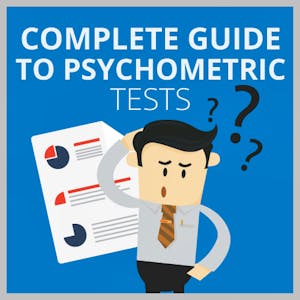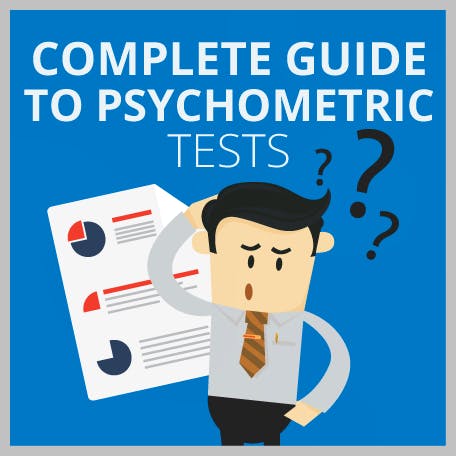15 Free Psychometric Test Questions and Answers
Updated November 18, 2023

- What Are Psychometric Tests?
- Who Uses Psychometric Tests?
- Why Are Psychometric Tests Used?
- Types of Psychometric Tests – Ability Tests
empty
empty
empty
empty
empty
- Types of Psychometric Tests – Psychometric Personality Tests
empty
- Psychometric Testing Examples
empty
empty
empty
empty
empty
empty
- How to Prepare for the Psychometric Test
- Frequently Asked Questions
- Final Thoughts

Psychometric tests are often used by organizations as part of the recruitment process. Different types of psychometric tests are designed to measure various aspects of cognitive ability, reasoning capabilities and personality traits. Potential employers use the results to assess a candidate’s suitability for a role. A psychometric test is generally administered online; this helps hiring managers filter applicants quickly and easily.
What Are Psychometric Tests?
Psychometric tests are also known as aptitude tests. They are an increasingly common part of the recruitment process.
They are used by companies across a range of industries to identify candidates' unique skills and abilities. This process is normally before the job interview stage of the hiring process. If you pass the assessment with a good score, you are more likely to be invited to interview.
This article is designed as a complete guide to the different types of psychometric tests. Find out what to expect, how to prepare and pick up some helpful tips to improve your score.
Generally speaking, psychometric tests consist of a series of timed questions. These most often assess numerical, verbal or logical reasoning skills.
Psychometrics are now primarily delivered online but you might also be invited to an assessment centre. You will be sent an email including a link that will enable you to access the test. You should research the test published before clicking on this link, so that you know what the test will look and feel like.
When psychometric tests have been used as an online screening tool, organizations tend to retest candidates at the official interview. This is to confirm that candidates answered honestly in their original test.
For this reason, it is not really worth cheating by trying to get someone else to help you pass online tests, as you will probably get caught out later.
Some newer psychometrics are ‘responsive’. This means they can react to a candidate’s performance on previous questions and present different questions depending on their achievement so far. This allows for an even greater level of discrimination between candidates.
The specific test you are asked to sit depends on what the company is looking for.
Although there are many different types of psychometric test, they fall into two main categories:
- Ability tests – To identify what an individual can do
- Personality tests – To identify personality traits and behaviors
Who Uses Psychometric Tests?
Psychometric tests are used often and are becoming increasingly common.
Between 75% to 80% of US Fortune 500 and UK Times 100 companies use them.
The rate of test use is also growing by 10% to 15% per year in the US across companies of all sizes.
Some of the companies that use psychometric tests include:
- Deloitte
- JP Morgan
- Microsoft
- McDonald’s
- Barclays
- Ernst and Young
- Pizza Hut
- Citigroup
- Hewlett Packard
- E.ON
They can be used effectively for candidates across job levels from entry-level to CEO roles.
Assessments are often tailored to the hiring organization. This means they relate directly to the industry and focus on specific skills employees need to succeed.
Why Are Psychometric Tests Used?
Psychometric tests are widely used because they are a cheap and effective way of distinguishing between candidates.
They can be administered to candidates early on in the process and don’t require a face-to-face meeting. This reduces the time and costs associated with selection.
Hiring managers use the results to determine which candidates are likely to be successful and be the best fit for the role.
Psychometric testing is particularly useful for ‘volume recruitment’. This is when a job attracts a large number of applicants.
In this case, psychometric tests are used to sift out candidates who don’t achieve a specified result on the test.
Psychometric tests are an objective way of comparing candidates without bias. Strengths and weaknesses can be evaluated without reference to academic or educational background.
Most importantly, they are one of the best predictors of job performance. Research has shown them to be 14 times more predictive of job performance than the average interview (Hunter, J.E. & Hunter, R.F. [1984] Validity and Utility of Alternative Predictors of Job Performance, Psychological Bulletin, 96, 72–98).
Let’s take a look at the two categories of psychometric tests in more detail.
Types of Psychometric Tests – Ability Tests
Ability tests are often known as cognitive ability tests. They are designed to assess different reasoning abilities.
The different tests are outlined below.
Numerical Reasoning Tests
Numerical reasoning tests assess a candidate's ability to understand and manipulate numerical data.
Numerical information is typically presented in the form of graphs, tables and charts.
They are often used for jobs where good numeracy is important. For example, analysts or accountancy roles.
Here are some common types of numerical reasoning tests:
- Data Interpretation: Data interpretation tests present numerical information in the form of graphs, tables, or charts. The test-taker must analyze the data and answer questions based on the information presented. This may involve calculating percentages, ratios, trends, or making comparisons.
- Arithmetic: Arithmetic tests assess a person's basic mathematical skills and ability to perform calculations. These tests may involve addition, subtraction, multiplication, division, percentages, ratios, and fractions.
- Financial and Business Calculations: Financial and business calculations tests focus on numerical concepts and calculations related to finance, accounting, and business scenarios. This may include topics such as profit and loss, interest rates, investments, currency conversions, and financial ratios.
- Numerical Sequences: Numerical sequence tests involve identifying patterns, relationships, or rules within a sequence of numbers. The test-taker must analyze the sequence and determine the missing number or the next number in the sequence.
- Quantitative Reasoning: Quantitative reasoning tests assess a person's ability to solve mathematical problems, often involving multiple steps or complex calculations. These tests may include algebra, geometry, numerical equations, and word problems.
- Currency and Unit Conversions: Currency and unit conversion tests evaluate a person's ability to convert between different currencies, units of measurement, or numerical systems.
Verbal Reasoning Tests
Verbal reasoning tests are designed to assess a candidate’s ability to understand and manipulate written material.
They are often used when the job requires a candidate to accurately read and interpret written information. For example, roles in marketing or customer services.
Here are some common types of verbal reasoning tests:
- Comprehension: Comprehension tests involve reading a passage of text and answering questions that assess understanding of the material. The questions may ask about specific details, main ideas, or the author's purpose.
- Vocabulary: Vocabulary tests assess a person's understanding of word meanings and their ability to use words in context. These tests may ask for definitions of words, synonyms or antonyms, or require completion of sentences with appropriate vocabulary.
- Sentence Completion: Sentence completion tests present a sentence with a blank or missing word, and the test-taker must choose the word that best completes the sentence in a grammatically correct and meaningful way.
- Analogies: Analogies involve establishing relationships between pairs of words and applying the same relationship to a new pair. The test-taker must identify the analogous relationship and select the option that best matches the given analogy.
- Critical Reasoning: Critical reasoning tests measure a person's ability to evaluate arguments and draw conclusions based on the information presented. These tests often involve identifying assumptions, identifying strengths and weaknesses in arguments, and evaluating the validity of claims.
- Deductive Reasoning: Deductive reasoning tests present a set of rules or premises and require the test-taker to draw logical conclusions based on those rules or premises.
Different tests may combine multiple types or use variations in presentation and complexity. It's important to familiarize yourself with the specific type of verbal reasoning test you will be taking and practice similar examples to improve your performance.
Abstract/Logical Reasoning Tests
Abstract/logical reasoning tests, also known as inductive reasoning tests or diagrammatic reasoning tests, assess a candidate’s ability to understand new information, identify patterns and spot trends.
Here are some common types of abstract reasoning tests:
- Pattern Recognition: These tests present a series of visual patterns or sequences, and the test-taker is required to identify the underlying pattern or rule and select the option that completes the series correctly. This can include patterns of shapes, colors, numbers, or other visual elements.
- Matrices: Matrices tests involve a grid or matrix with a pattern of shapes or symbols. The test-taker must identify the missing shape or symbol that completes the logical sequence or pattern within the grid.
- Odd One Out: In these tests, a series of shapes, symbols, or patterns is presented, and the test-taker must identify the item that does not fit the pattern or is different from the others. The task is to find the "odd one out" among the given options.
- Series Completion: This type of abstract reasoning test presents a series of shapes, symbols, or patterns with one or more missing elements. The test-taker must identify the logical rule or pattern and choose the correct option that completes the series accurately.
- Analogies: Analogies involve establishing relationships between pairs of shapes, symbols, or patterns and applying the same relationship to a new pair. The test-taker must identify the analogous relationship and select the option that best matches the given analogy.
- Figural Classification: Figural classification tests require the test-taker to categorize or group a set of shapes, symbols, or patterns based on their shared characteristics. The task is to identify the rule or common feature and select the group that follows the same pattern.
As they require no specific learned skills to complete, they are often seen as the ‘purest’ test of ability. They are less affected by education level or previously learned information.
Abstract reasoning tests tend to be used for jobs where the candidate will need to problem solve effectively, manage new situations and understand how different elements can interrelate.
They are often used to assess cognitive ability for leadership and managerial roles.
Mechanical Reasoning Tests
Mechanical reasoning tests evaluate competence in mechanical or technical ability.
They tend to be used for jobs where there is a need to understand how things work technically, such as engineering roles.
Some of the common topics tested are:
- Gears and levers
- Pulleys
- Springs
- Gravity and pressure
- Screws
- Acceleration
- Weights and volumes
- Friction
Other questions might require an understanding of simple electrical circuits or applied math.
Critical Thinking Tests
Critical thinking tests aim to assess candidates’ ability to think critically about information.
This includes analyzing, conceptualizing and reasoning.
To be successful, candidates must be able to structure and appraise arguments, identify assumptions and inferences, and understand and synthesize information.
These psychometric tests are primarily used for lawyers, but they are also used by other organizations where a high level of analysis is required.
Types of Psychometric Tests – Psychometric Personality Tests
Personality tests aim to understand a person’s character and how they are likely to behave. They are used to analyze your emotions, values and motivations.
There are many different psychometrics character tests available.
Some are based around the ‘Big Five’ personality traits:
- Openness to Experience
- Conscientiousness
- Extraversion
- Agreeableness
- Neuroticism
For example, the Predictive Index (PI) behavioral assessment.
Other personality tests are particularly relevant to the workplace, such as the Occupational Personality Questionnaire (OPQ) or to assess how an individual is likely to respond to authority.
Some assess how individuals are likely to behave under pressure, such as the Hogan Dark Side assessment.
Another popular assessment is the 16 personalities test or the MBTI. These identify which profile matches your character based on psychological preferences.
Personality tests often present statements that you must agree or disagree with.
Tests of personality don’t have right or wrong answers. They are designed to assess your unique character traits and preferences.
There are usually no time limits but take around 15 to 30 minutes on average to complete.
They can consist of between 50 to 200 questions and assessment tests are generally taken online.
Situational Judgment Test
A Situational Judgment Test (SJT) is a popular way of assessing an individual’s character traits in relation to a specific industry.
These tests relate directly to the situations an applicant is likely to encounter in the workplace.
The questions are designed to reveal your decision-making skills and thought processes.
While there may be no right or wrong answers, certain options will align more closely with the type of person the hiring manager is looking for.
It is advisable to research the likely behaviors and responses required for the job. This can help guide your choices.
However, it is recommended to select answers that don’t reflect your individual natural behaviors.
If you need to prepare for a number of different employment tests and want to outsmart the competition, choose a Premium Membership from JobTestPrep.
You will get access to three PrepPacks of your choice, from a database that covers all the major test providers and employers and tailored profession packs.
| Preserve Consumption Per Capita (kg) | ||||||||||
|---|---|---|---|---|---|---|---|---|---|---|
| Country | Strawberry Jam | Raspberry Jam | Apricot Jam | Plum Jam | Marmalade | |||||
| 2015 | 2016 | 2015 | 2016 | 2015 | 2016 | 2015 | 2016 | 2015 | 2016 | |
| UK | 3.1 | 4.1 | 2.8 | 3.3 | 1.1 | 1 | 0.8 | 0.6 | 2.4 | 3.1 |
| Ireland | 1.2 | 2.3 | 2.6 | 2.9 | 2.2 | 2.2 | 1.9 | 2.2 | 1.1 | 1.3 |
| France | 4.1 | 4.0 | 3.7 | 3.9 | 4.6 | 4.8 | 2.0 | 2.3 | 0.7 | 0.5 |
| Argentina | 2.5 | 2.7 | 2.6 | 2.9 | 2.2 | 2.5 | 1.7 | 1.5 | 2.9 | 2.9 |
| India | 1.7 | 2.8 | 1.3 | 2.5 | 1.1 | 2.0 | 2.6 | 3.1 | 1.8 | 2.4 |
1. What was the most popular flavor of preserve in 2016?
a) Strawberry Jam
b) Raspberry Jam
c) Apricot Jam
d) Plum Jam
e) Marmalade
2. Which country had the greatest percentage increase in preserve consumption from 2015 to 2016?
a) UK
b) Ireland
c) France
d) Argentina
e) India
3. In 2015, people in the UK ate an average of 20% more preserve in 2014.
What was the average preserve consumption per capita in 2014?
a) 7.24 kg
b) 8.16 kg
c) 8.50 kg
d) 8.72 kg
e) 9.27 kg
1. You will be presented with a passage to read and a statement about that passage. You must select one of the following answers:
True: The statement follows logically from the information contained in the passage
False: The statement is logically false from the information contained in the passage
Cannot say: It is not possible to determine whether the statement is true or false without further information
‘Working in a holiday resort is a popular option for graduates wishing to see the world. It gives them the opportunity to experience foreign cultures, make friends and build lifelong memories. As the skills required for securing a job tend to be low, most graduates choose not to turn their experience into a career, but enjoy the time they spend abroad. But there is a dark side to this kind of casual work: often workers’ rights are ignored and they may find themselves working long hours for very little money, as holiday resorts often do not adhere to the standards we might expect in the UK.’
Statement 1: Many graduates enjoy working in holiday resorts so much they choose to develop a career in hospitality.
Statement 2: All graduates who spend time working in holiday resorts make friends.
Statement 3: Graduates working in holiday resorts often find that the pay and working conditions are lower than they might expect in the UK.
2. Correct the spelling and grammatical errors in the text below.
‘Many cat owners’ love there animals very much. It can be dificult four them to understand why other’s don’t also enjoy they’re company. Living with someone who cat’s effect differently can be hard particularly if their allergic, but with practice gets easier’
3. You have invited a number of colleagues to a meeting.
Please rank their responses from the most to least positive:
Responses:
- Ok, sounds good, please can you send me the agenda?
- I’m sorry, I can’t make it, but thanks for inviting me.
- No. That’s not convenient for me, and I don’t think I need to be there anyway.
- Great – I’ll look forward to seeing you there.
- Is it important that I’m there? Is there any chance I could grab the minutes from someone instead?
1. Look at the items in the top row and decide which of the items in the bottom row comes next in the sequence:

2. Look at the items in the top row and decide which of the items in the bottom row comes next in the sequence:

1. A vehicle is traveling at a velocity of 65 m/s.
What is the velocity of the vehicle in mph?
a) 130 mph
b) 140 mph
c) 145 mph
d) 150 mph
2. A person weighs 61 kg on Earth. What would they weigh if they were on the moon?
a) 10 kg
b) 6.1 kg
c) 23 kg
d) 16 kg
3.

How much force is required to lift the weight?
a) 45 lbs
b) 50 lbs
c) 60 lbs
d) 70 lbs
- Read the passage below and say whether each statement is ‘true’, ‘probably true’, ‘insufficient data’, ‘probably false’ or ‘false.’
Ethan runs a publishing company. For the past five years, profits have been rising every year. 2022 was the most successful year to date. To celebrate this, Ethan decided to take his staff for a meal at a five-star restaurant in the city.
Statement 1: Ethan is very wealthy.
Statement 2: Ethan’s company performed well in 2021.
Statement 3: The staff are happy to work at Ethan’s company.
2. Read the statement below and deduce whether the conclusions presented follow or do not follow.
Statement: ‘Some Saturdays are sunny. All sunny days are fun. Therefore:’
- No cloudy days are fun.
- Some Saturdays are fun.
- Some Saturdays are not fun.
1. Read the statements and decide whether you agree, strongly agree, disagree, strongly disagree or neither.
- ‘I prefer to work as part of a team.’
- ‘I often take charge before other people do.’
- ‘I push myself to succeed in all I do.'
- ‘I don’t understand those who get emotional.’
- ‘I work well under pressure.’
2. Read the following situation and decide which is your most likely and least likely response.
‘It is 9 a.m., and you have received an email from your line manager. They have moved the deadline for your current project to the end of the day at 5 p.m. You estimate the work will take approximately 10 hours to complete by yourself but could be reduced if you work with a colleague. However, you also have two other less important tasks to complete by lunchtime.’
Responses:
a) Immediately inform your line manager that you can’t possibly complete the task by 5 p.m. and they will have to change the deadline.
b) Discuss the situation with a colleague and request some support with delegating the less important tasks to other team members.
c) Start work immediately on the project and hope it can be completed by 5 p.m. if you leave out the less important aspects and rush.
d) Reply to your line manager and politely explain your current workload. Ask if there is any way they can assist you with this.
How to Prepare for the Psychometric Test
Preparing in advance is essential for the best chance of success. Knowing what to expect on test day gives you a competitive edge over other candidates.
Some specific ways to help you do your best are provided below.
Step 1. Use Practice Tests
Take at least one practice psychometric test online – and do more if you can. Example questions can help you understand more about the format and question styles you should expect.
Most online sample questions, such as the ones found on JobTestPrep, include answers and explanations.
Read these carefully and practice the methods. Then you can apply similar techniques to the questions you encounter in your real test.
Completing lots of practice questions will allow you to identify areas where you need to revise or learn new techniques.
They also equip you with strategies to solve the questions and decode them more effectively.
For example, the more you practice abstract reasoning tests, the more familiar you become with the ways the questions are constructed.
It is also worth revising for numerical and mechanical reasoning tests to ensure the tools, techniques and formulas are at the forefront of your mind.
Step 2. Consider Timings
Most psychometric tests are timed. This adds pressure and increases stress levels, which reduces your focus.
Complete practice tests under timed conditions. You will learn how you cope under time pressure and develop strategies to cope.
Monitoring your time also helps you understand how long you spend on each question.
If you do struggle with a question, move on and make a note to revise similar questions during your next study session.
Don’t panic if you don’t complete all the questions in the allocated time. Some tests are designed to increase in difficulty and not all candidates will reach the end.
Remember that organizations are looking for a combination of speed and accuracy. Don’t rush through your test without checking your answers before submitting them.
Step 3. Focus on Your Well-Being
To get the best score in your psychometric assessment, you need to be functioning at your best mentally and physically.
Boost your chances of success by making sure you are on top form for the test. Tiredness and hunger can negatively impact your performance.
Get adequate sleep the night before, and eat a healthy meal to set you up for the day.
This tip applies to your study preparation time and test day. Arrange your study time for when you feel most alert and able to concentrate.
Practice some mindfulness techniques before your assessment. Some deep breathing can help center you and help you remain calm throughout.
Take your test at a time of day when you feel most alert.
Step 4. Check Your Equipment
Before you sit your test, make sure all your necessary equipment is working correctly.
Plug in your device and check your internet connection is strong. Disable notifications on your mobile to limit interruptions.
Have a pen and paper to hand in case you need to jot down any notes during the assessment.
Don’t forget to have a glass of water nearby. Remember you may not be able to take a break during your test.
Step 5. Find a Quiet Environment
A quiet environment is essential for studying and sitting your test.
Find a good location that feels secure and peaceful. Try to sit at a desk or table in a room with good lighting.
Don’t forget to inform others that you need some space to work. It is difficult to concentrate if you are disturbed.
Place a sign on the door if you need to, and turn off notifications on your phone and/or computer.
Step 6. Check Role Requirements
Check the role requirements and job specification. If you are applying for a position that needs excellent math skills, focus your study on numerical reasoning.
For personality assessments, it is not recommended you select answers that do not match your true response.
However, it is worth bearing an organization's needs in mind. Think about what they are looking for in a candidate and reflect this in your answers.
Step 7. Be Honest and Consistent
While matching the role requirements is important, it isn’t a good idea to be dishonest in your answers.
Being truthful is important to make sure you are the right candidate for the role.
If you provide answers that don’t reflect your true character, you could end up in a job you don’t enjoy.
Read all instructions carefully before you start so you don’t miss any crucial information.
A psychometric test is a non-biased way of assessing the suitability of candidates for a role. Psychometric tests are a common part of the recruitment process and preparation beforehand will improve your chances of success.
There are two main types – ability tests and personality tests. These are designed to identify reasoning abilities and personality traits.
Psychometric tests can be difficult to pass. This is why practicing beforehand is vital. It gives you an understanding of the types and styles of questions you are likely to encounter.
It also helps you identify your strengths and weaknesses so you can focus your study on these areas.
You can prepare by taking at least one practice psychometric test online. There are various free and premium psychometrics examples available.
JobTestPrep has sample questions with explanations to help you learn about the question styles.
Yes, you can fail a psychometric assessment. This means you haven’t met the standards required by the employer.
If you fail a personality test, this may mean you aren’t the right fit for the company and you wouldn’t have been happy in the role.
If you do fail your test, keep practicing and try to improve your skills for next time.
Generally, you are unable to retake a psychometric test if it is taken during the initial stages of the recruitment process. You will be able to take similar tests if you apply for another role that requires you to sit a psychometric test.
A psychometric assessment is used to identify suitable candidates for a role. The results guide hiring managers in matching the job specifications with the skills, abilities and personalities of the applicants.
More sample questions can be found at JobTestPrep. Other sample questions are available free online. Practicing psychometric tests is the best way to help improve your confidence and your chance of success.
The best way to prepare for a psychometric test is by practicing in advance of your test. Find out which test, or tests, you have been asked to sit. Then use sample questions and tests online to familiarize yourself with the questions. You can find a paid-for or free psychometric test online.
The number of questions depends on which particular test you are taking. Some types of psychometric tests, such as personality tests, can contain hundreds of questions. Most psychometric questions are multiple-choice.
Most psychometric tests are timed. They may take on average 20 to 30 minutes to complete. Check with the test provider if you are unsure so you know what to expect on test day.
A complete guide to psychometric tests can be found on JobTestPrep. It includes practice tips and sample questions to help prepare you for your assessment.
A range of different companies require taking a psychometric test. You may be asked to sit more than one or a test that is a combination of different ones. Some companies include MacDonald’s, Ernst & Young, JP Morgan and Deloitte.
If you need to sit a test, you will be informed as part of the recruitment process.
Final Thoughts
Psychometric tests are a common tool used as part of the recruitment process.
Tests are used because they indicate who is likely to be able to successfully complete a job. If you don’t pass the test, there’s a strong chance you wouldn’t enjoy the job anyway.
Practice a range of different psychometric tests to prepare you for test day. Familiarization with the format and style of questions helps you feel more confident.
Remember that psychometric tests are only one part of the selection procedure.
They are used alongside your application and other exercises, which means there are other ways to impress your potential employer.
Aim to achieve the highest score possible to increase your chances of securing an interview.











